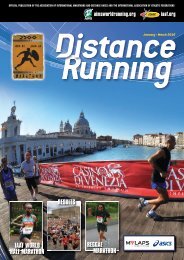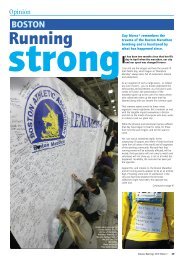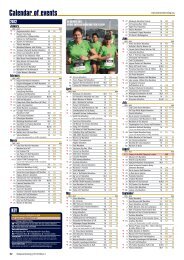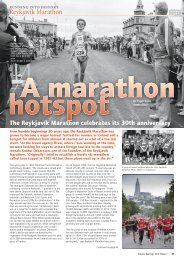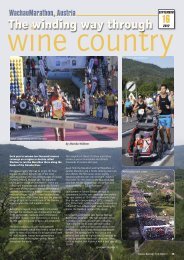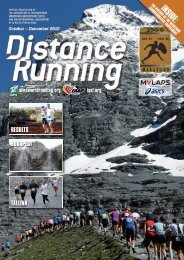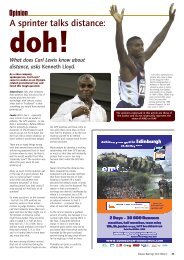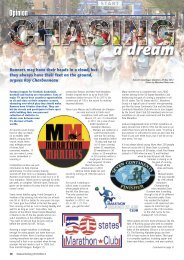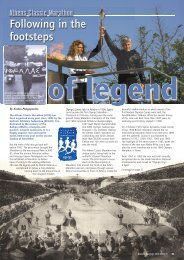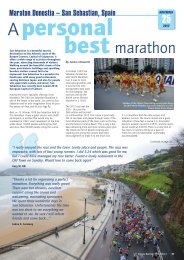Download pdf - Distance Running magazine
Download pdf - Distance Running magazine
Download pdf - Distance Running magazine
Create successful ePaper yourself
Turn your PDF publications into a flip-book with our unique Google optimized e-Paper software.
A class of his own<br />
Dr David Martin marvels at the unique talent<br />
of Haile Gebreselassie<br />
In the Berlin Marathon on 30<br />
September last year Haile<br />
Gebrselassie chopped 29 seconds<br />
from Paul Tergat’s three-year old<br />
2:04:55 marathon world record, set<br />
on the same course four years<br />
earlier. That achievement led many<br />
to suggest that Geb’s career had<br />
now earned him the ultimate<br />
accolade: ‘the greatest distance<br />
runner ever.’<br />
He was already a two-time Olympic<br />
gold medalist (at 10,000m), and a<br />
four-time World Champion (at<br />
10,000m). This marathon<br />
performance was his 18th IAAFapproved<br />
world record, over<br />
distances starting at 3000m,<br />
achieved during a period from 1994<br />
through 2007. But he also had run<br />
faster than anyone else over seven<br />
other distances as well (see table).<br />
Racing the final kilometers alone in<br />
Berlin, with a spectacular negative<br />
split of 1:01:57 after a 1:02:29 first<br />
half, Gebrselassie demonstrated that<br />
the marathon distance was well<br />
under his control – especially on<br />
that day of ideal weather conditions<br />
(16C, overcast and no wind).<br />
Just how fast is 2:04:26 in the<br />
world of marathon running? Those<br />
of us back in the pack find such a<br />
finish time for a marathon footrace<br />
rather unfathomable. One way of<br />
appreciating it is to run one 4:44<br />
mile after another, for 26 miles,<br />
plus a little farther to cover the<br />
remaining 385 yards. Those who do<br />
not run marathons may be able to<br />
visualize it in terms of pace per<br />
400m – one lap of a standard<br />
athletics track. Run around that<br />
400m track once in 70.8 seconds,<br />
and now do this 104 more times<br />
without taking a break, and you’ll<br />
still be tied with Geb – but you’ll<br />
have to continue onward at that<br />
pace for another half lap to the<br />
finish. [Equally amazing is that<br />
Paula Radcliffe raced at 77.0<br />
seconds pace per 400 meters when<br />
she achieved her 2:15:25 world<br />
record at London in 2003.] That’s<br />
endurance!<br />
Another interesting question is:<br />
‘which of Gebrselassie’s records is<br />
the best?’ In order to compare each<br />
of the races, one must find a way to<br />
analyze 16 different combinations<br />
of running surface (road and track),<br />
environment (indoors and out), and<br />
distance (3000m, 2 miles, 5, 10,<br />
and 15km, 10 miles, 20km, onehour<br />
run, half marathon, 25km,<br />
and marathon). The science of<br />
exercise physiology provides a tool<br />
for comparative assessment of the<br />
outdoor competitions.<br />
When we exercise, our breathing<br />
quickens and deepens. This brings<br />
oxygen into the working muscles<br />
and allows metabolism to produce<br />
energy for muscle movement. The<br />
largest volume of oxygen that can<br />
be absorbed and utilized is a<br />
quantity called VO2-max. The units<br />
of this quantity are volume of<br />
oxygen in millilitres per<br />
kilogramme of body weight, per<br />
minute. VO2-max is partly<br />
determined by genetics, partly by<br />
running efficiency, but also by<br />
training – running distances at a<br />
faster pace tends to raise one’s<br />
VO2-max. In top-class distance<br />
races, the men at the front all have<br />
VO2-max values in the 70 to 90<br />
range. Women are smaller in size<br />
and at the top end of performance<br />
have VO2-max values from about<br />
65 to 80 ml/kg/min. Without going<br />
into detail, prediction tables permit<br />
estimates of performance times<br />
achievable over various distances at<br />
THE 25 WORLD-BEST PERFORMANCES OF HAILE GEBRSELASSIE<br />
DATE VENUE DISTANCE TIME RECORD STATUS VO2 VALUE<br />
04-Jun-1994 Hengelo "5,000 m" 12:56.96 IAAF 82.5<br />
27-May-1995 Kerkrade 2 miles 8:07.46 non-IAAF 81.3<br />
05-Jun-1995 Hengelo "10,000 m" 26:43.53 IAAF 83.5<br />
16-Aug-1995 Zuerich "5,000 m" 12:44.39 IAAF 84.1<br />
27-Jan-1996 Sindelfingen "5,000 m (i)" 13:10.98 IAAF<br />
04-Feb-1996 Stuttgart "3,000 m (i)" 7:30.72 IAAF<br />
20-Feb-1997 Stockholm "5,000 m (i)" 12:59.04 IAAF<br />
31-May-1997 Hengelo 2 miles 8:01.08 non-IAAF 82.5<br />
04-Jul-1997 Oslo "10,000 m" 26:31.32 IAAF 84.2<br />
13-Aug-1997 Zuerich "5,000 m" 12:41.86 IAAF 84.4<br />
25-Jan-1998 Karlsruhe "3,000 m (i)" 7:26.14 IAAF<br />
15-Feb-1998 Birmingham "2,000 m (i)" 4:52.86 non-IAAF<br />
01-Jun-1998 Hengelo "10,000 m" 26:22.75 IAAF 84.7<br />
13-Jun-1998 Helsinki "5,000 m" 12:39.36 IAAF 84.7<br />
14-Feb-1999 Birmingham "5,000 m (i)" 12:50.38 IAAF<br />
11-Dec-2002 Doha "10,000 m" 27:02 IAAF 82.3<br />
21-Feb-2003 Birmingham 2 miles (i) 8:04.69 non-IAAF<br />
04-Sep-2005 Tilburg 15 km 41:22 unofficial 82.3<br />
04-Sep-2005 Tilburg 10 miles 44:23 non-IAAF 82.8<br />
15-Jan-2006 Tempe 20 km road 55:48 IAAF 82.9<br />
15-Jan-2006 Tempe 1/2 marathon 58:55 IAAF 83.2<br />
12-Mar-2006 Alphen aan den Rijn 25 km 1:11:37 no drug testing 81.7<br />
27-Jun-2007 Ostrava 20 km track 56:25.98 IAAF 82<br />
27-Jun-2007 Ostrava 1 hour run "21,285 m" IAAF 82.3<br />
30-Sep-2007 Berlin marathon 2:04:26 IAAF 82.4<br />
i = indoor<br />
IAAF = world record as accepted by the International Association of Athletics Federations<br />
non-IAAF = world best time over a distance not recognized by the IAAF<br />
a wide range of VO2-max levels.<br />
The right column in the<br />
accompanying table indicates the<br />
VO2-max level required to achieve<br />
Gebrselassie’s outdoor road and<br />
track performances.<br />
Notice that Geb’s 10,000m Hengelo<br />
performance in June of 1998, as<br />
well as his 5000m race two weeks<br />
later at Helsinki, appear to be his<br />
best efforts to date. Working at a<br />
metabolic rate (represented as VO2-<br />
max in ml/kg/min) of 84.7<br />
ml/kg/min, this brought finish times<br />
of 26:22.75 for 10000m and<br />
12:39.36 for 5000m. Note also,<br />
however, that Geb’s 2:04:26 at<br />
Berlin, despite being 29 seconds<br />
faster than Tergat’s then exisisting<br />
record, required a slightly smaller<br />
VO2-max value (82.4) than the<br />
84.7 value for the two track<br />
performances. What do the<br />
performance tables say that Geb<br />
could have run for the marathon<br />
while working at an energy level of<br />
84.7 ml/kg/min? The answer is an<br />
amazing 2:01.32<br />
This value prompts one final<br />
question: Could Haile Gebrselassie<br />
become the first person to break the<br />
two-hour barrier in the marathon?<br />
Present-day charts using VO2-max<br />
as a predictor stop at 85 ml/kg/min,<br />
which suggest a 2:01:10 marathon<br />
under ideal conditions. That would<br />
be a top-end improvement in<br />
performance capability required for<br />
Gebrselassie. Who knows? My<br />
prediction from analyzing<br />
mountains of marathon finish times<br />
is that this two-hour barrier will<br />
not be broken before 2015. And<br />
Geb will likely have retired before<br />
then. But his charismatic smile and<br />
effortless style of running will do<br />
much to bring the best out of his<br />
competitors as the next group tries<br />
to emulate this ‘greatest distance<br />
runner ever.’<br />
THE OPINIONS EXPRESSED IN<br />
THIS ARTICLE ARE THOSE OF THE<br />
AUTHOR AND DO NOT<br />
NECCESSARILY REPRESENT THE<br />
VIEWS OF AIMS OR IAAF<br />
<strong>Distance</strong> <strong>Running</strong> January – March 2008<br />
41



